Differential Diagnosis in Internal Medicine: From Symptom to Diagnosis epub
Par hensen sara le lundi, mai 22 2017, 00:54 - Lien permanent
Differential Diagnosis in Internal Medicine: From Symptom to Diagnosis. Walter Siegenthaler

Differential.Diagnosis.in.Internal.Medicine.From.Symptom.to.Diagnosis.pdf
ISBN: 1588905519,9781588905512 | 1143 pages | 20 Mb

Differential Diagnosis in Internal Medicine: From Symptom to Diagnosis Walter Siegenthaler
Publisher:
The etiology of the disease is unknown. Differential diagnosis may include retrocecal appendicitis, bacterial infection or avascular necrosis of the hip, renal colic and pyelonephritis, arthritis, hip joint infection, S1 disc herniation, inflammatory bowel disease, epidural abscess, vertebral osteomyelitis, pelvic inflammatory Psoas abscess: a primer for the internist. Blood tests can be performed to diagnose celiac disease; these include endomysial antibodies, anti-tissue transglutaminase antibodies, and anti-gliadin antibodies. The differential diagnosis included neuroendocrine neoplasm, gastrointestinal stromal tumor (GIST), paragangglioma and neoplasm of melanocytic origin. 2 Department of Internal Medicine, Athens Navy Hospital, Athens, Greece. Making a differential diagnosis is crucial especially when the symptoms of a urinary tract infection may mimic that of other diseases that manifest similar symptoms. The fact is that each of those named disorders above is the end of the road for the differential diagnostic methodology. Differential Diagnosis in Internal Medicine: From Symptom to Diagnosis Walter Siegenthaler Language: English Page: 1143. Do they correspond with the symptoms in question? The NP thought the symptoms could have a metabolic etiology and ordered an MRI and EEG plus blood folate, vitamin B12, vitamin D, and homocysteine levels. Learn more about internal medicine with continuing learning education. How can the preliminary diagnosis be confirmed? Download Differential Diagnosis in Internal Medicine: From Symptom to Diagnosis. There is no cure for celiac disease. 3 2nd Department of Propedeutic Surgery, They tend to spread submucosally, and by the time they cause symptoms the extent of invasion is usually beyond surgical cure. All bariatric surgery, neurology, and internal medicine experts opined that failing to diagnose WE in a post–gastric bypass patient, with hyperemesis, who displayed the classic signs of confusion, nystagmus, and ataxia with an MRI abnormality in the There was failure to establish a differential diagnosis. The classic symptom triad described by Myntner in 1881 of fever, abdominal or flank pain, and limp is present in less than 8 percent of cases.